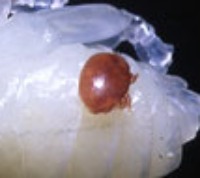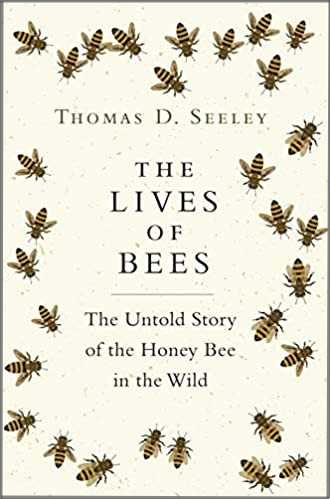Varroa Treatment
There are a number of varroa treatments used by beekeepers, but with all treatments for this dreaded mite. You may wish to gain advice from your Bee Inspector with regard to the appropriate dose, in order to avoid harm to the honey bee colony. This page looks at chemical and non-synthetic controls. However, it is only an introduction at this stage. Please visit again for further information.
Varroa Destructor And Chemical Control
One of the perhaps controversial methods of controlling varroa
mite is in the use of what are essentially pesticides to control an
insect pest on another insect.
These are administered to a colony by placing plastic strips impregnated
with the chemical, inside the hive. An example of a chemical varroa
treatment is Apistan, which is a pyrethroid pesticide – note pyrethroids
are chemical pesticides also used by farmers on crops.
 Varroa on honey bee pupae
Varroa on honey bee pupae
However, the mites have been found to develop resistances to the chemical treatments, and it is perhaps a grim irony that an EU motion proposed to assist agro-chemical companies in the marketing of their bee medicines - bee medicinces (opens a new window).
I found an interesting point of view expressed in a book by Phil Chandler, author of “The Barefoot Beekeeper” and 'Managing The Top Bar Hive". He said:
“It is interesting to note that, while agri-chemical corporations,
such as Bayer, were selling pyrethroids to beekeepers as mite
treatments, they were simultaneously selling them to farmers to spray
onto crops. It would hardly be surprising if these low-level
applications onto pollen-bearing crops turn out to have contributed to
the rapid build-up of pyrethroid resistance among Varroa populations in
our hives.”
He then goes on to say:
“Our recent experience with Varroa has demonstrated that this pest can develop immunity to chemical treatments in a very short time. By using such an approach, we are simply helping along the evolution of the mite, by selecting for immunity to treatments: those mites that survive our assault go on to breed with other survivors, carrying the immunity as a genetic trait.”
Dr David Heaf has a further interesting view:
"I have never treated my bees in the Warrés. I stopped treating my bees in Nationals in January 2009. I live in a locality where quite a number of beekeepers, including our bee disease inspector (who I think coined the term no-treatment nutters), do not treat for Varroa.
My view is that any treatment that works against the mite, e.g. acaricides, or in favour of the bee vis-à-vis the mite, e.g. sugar dusting, only postpones the day when bee and Varroa will and must co-adapt.
The bee has been around for millions of years. It has developed ways of dealing with ectoparasites such as mites. But it needs to be constantly challenged by Varroa in order to elicit the defence behaviours latent in the bee. Destroying Varroa reduces that challenge.
I do not recommend this approach to, say, a beginner with one or two hives, as there is a high risk of them losing all.
My current loss rate is about 30% which is about three times higher than in the days before Varroa arrived".
Personally, I’m more in favour of keeping synthetic chemicals out of
bee hives, especially pesticides.
Thomas D. Seeley in The Lives Of Bees promotes the idea that bees need to be allowed to evolve their own methods of dealing with the mite. He also compiles research of healthy wild colonies to make suggestions to beekeepers to help them rear healthier colonies.
You may wish to look in to Seeley's ideas, or go along with David Heaf's approach, but in the meantime, here are some alternative solutions for varroa mite, used by some beekeepers.
Icing-Sugar Treatment For Varroa (also referred to as Powdered Sugar)
This varroa treatment is best used with mesh floors, which allow mites to fall
clear away from the bee colony.
It can be applied by trickling the sugar between frames, or sieving it over the bees, or blowing it. It works by causing the mites to lose their grip on the body of the bee, hence they fall off. Icing sugar can also be applied when introducing a new swarm to an empty hive, to protect against any mites that may have hitched a lift into their new home.
NOT caster sugar.
Other Natural/Non-Synthetic Varroa Treatments
- These include formic, oxalic and lactic acids. Lemon juice is of course acidic. I read an interesting study that showed lemon juice to be effective in controlling varroa mite, with reduction of Varroa to reach upto 86.6%. You can read about this study here: Varroa and Lemon Juice Treatment
- Thymus powder (as in, derived from the Thymus or Thyme plant) can also be placed inside the hive on a shallow tray.
